Top Round Beef Cutlet Recipe Panko
This post may contain affiliate links. Please read my disclosure policy for details. As an Amazon Associate, I earn from qualifying purchases.
Tonkatsu (Japanese Pork Cutlet) is one of the simplest meals you can make at home. Every bite is perfectly crunchy on the outside and juicy on the inside with the added flavor from Tonkatsu Sauce!
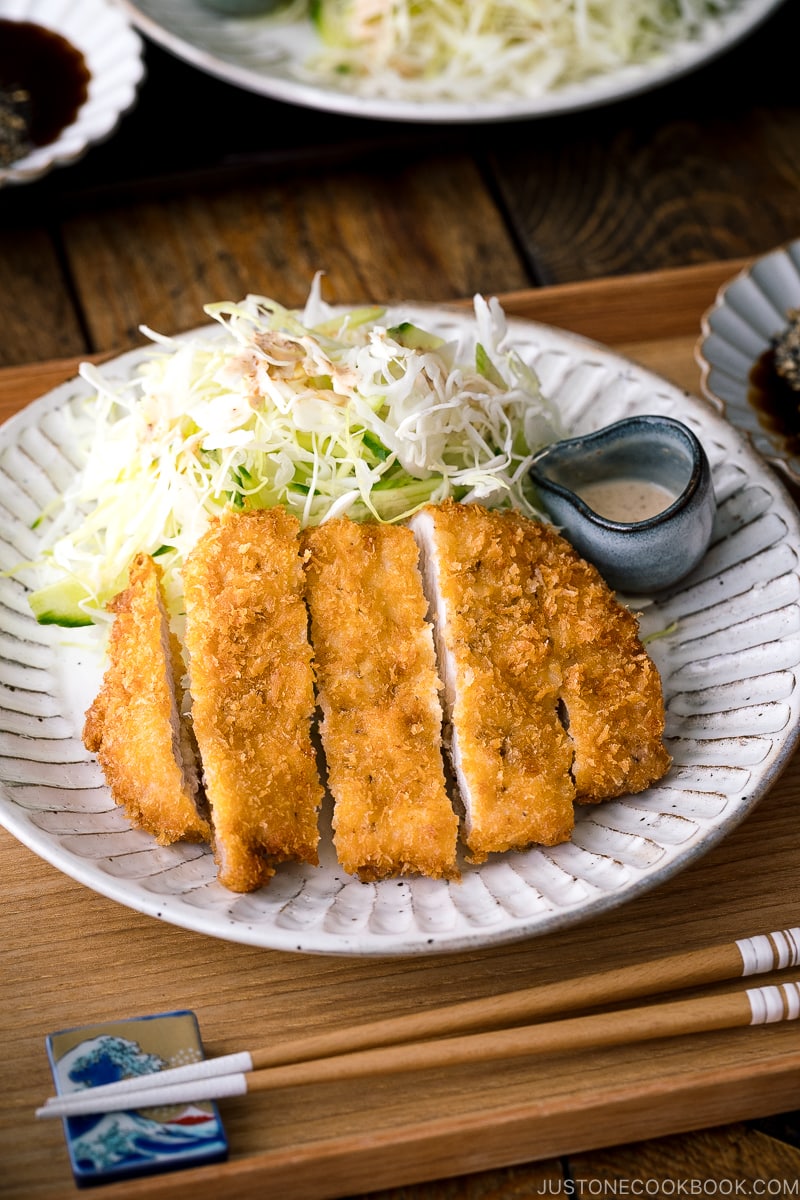
We have a specialty in Japan known as Tonkatsu (とんかつ, 豚かつ) or deep-fried pork cutlet. This western-inspired dish has been enjoyed for over 120 years, with the recipe remaining mostly unchanged since then. So, what makes Tonkatsu special, and how can we make this popular dish at home? Believe it or not, making Japanese pork cutlet at home is easier than you think and should take no more than 30 minutes!
What is Tonkatsu?
For those of you who are new to this Japanese dish, tonkatsu consists of tender pork loin (or fillet) that has been breaded and deep-fried to crunchy perfection. The wordTon (豚) comes from "pork" andKatsu (カツ) is an abbreviation ofKatsuretu (カツレツ), derived from the English word "cutlet."
Like many other popular foods in Japan (think ramen, tempura, soba, etc.), there are tonkatsu restaurants that exclusively serve this juicy pork cutlet as their specialty. And no plate of tonkatsu is ever complete without a mound of freshly shredded cabbage and a healthy drizzle of tonkatsu sauce.
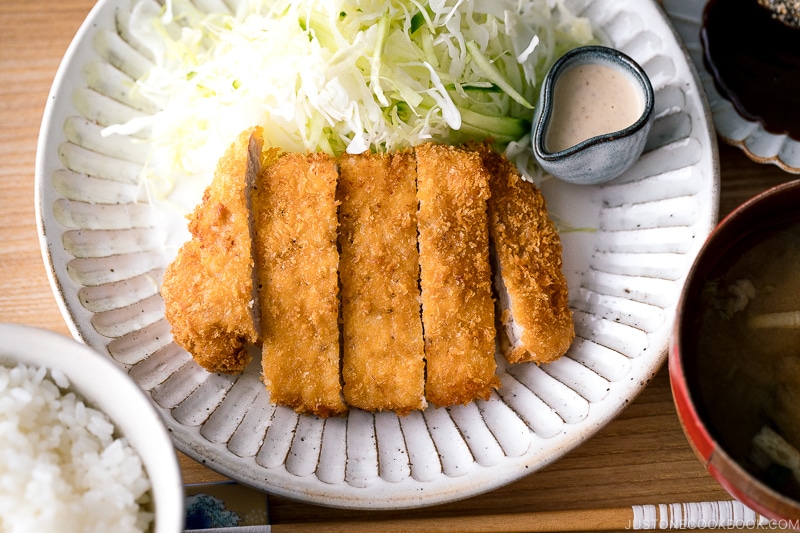
A Brief History
Before tonkatsu exploded in popularity as a pork dish in the early 20th century, it was mainly made with beef. When the recipe first appeared around the 1870s, it was already considered a Yoshoku meal (i.e., a Japanese dish inspired by western cuisine). It wasn't until a couple of decades later that pork would be substituted for beef, becoming the beloved food we enjoy today.
Tonkatsu is said to be inspired by the French dish, côtelette de veau, which is essentially breaded veal cutlet pan-fried in butter. One Tokyo restaurant called Rengatei 煉瓦亭 (still open today!) took this concept and made a few changes to appeal to the Japanese palette, and in 1899, Tonkatsu made its debut.
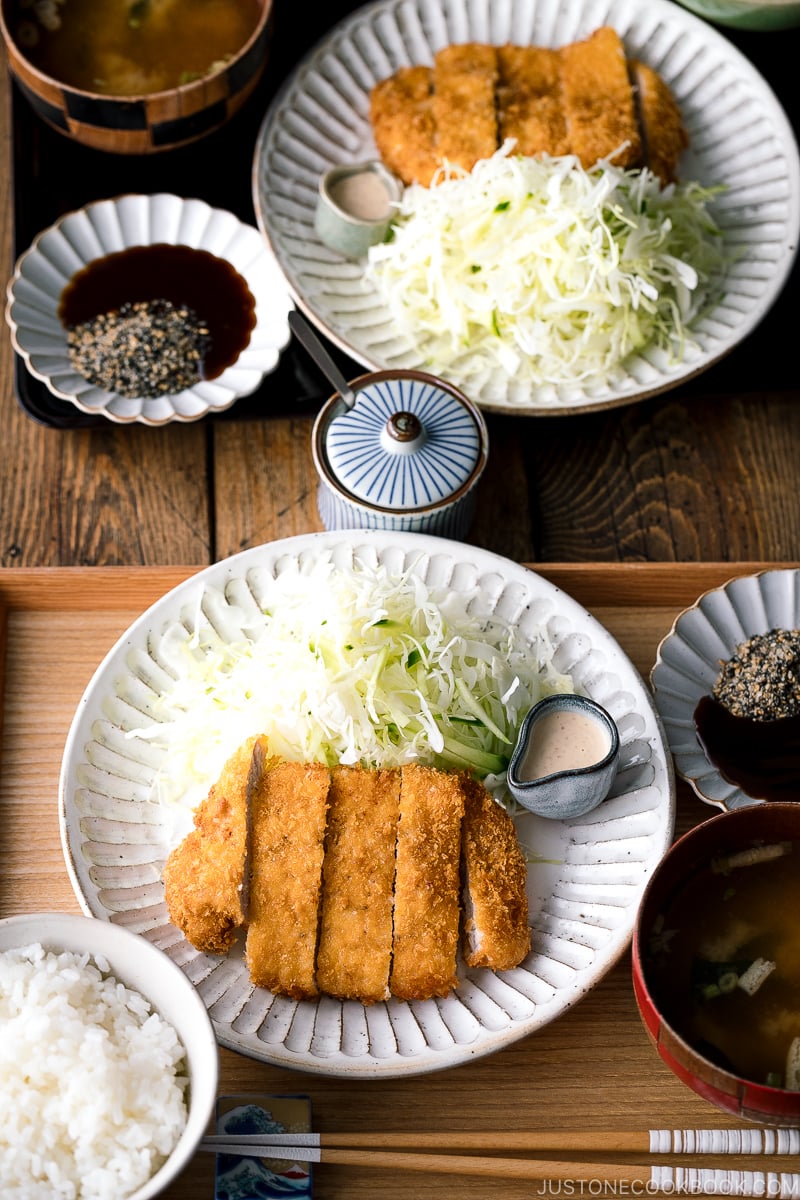
What Makes Tonkatsu Different from Other Cutlets?
By the looks and sounds of it, Tonkatsu seems a lot like other popular fried cutlet dishes such as German schnitzel, Polish kotlet schabowy, and Italian piccata. What makes the Japanese pork cutlet different?
- Breading – Rather than using finely ground, stale breadcrumbs, Tonkatsu requires panko (パン粉), a Japanese-style breadcrumb made from soft white bread without the crust. Panko flakes are larger than standard breadcrumbs and absorb less oil when fried. This results in an airy, crispy coating (like tempura) that doesn't feel too heavy.
- Deep-frying – Instead of pan-frying which can results in tougher and greasy meat, deep frying gives the pork a crispy outside and juicy center that is now a key characteristic of the dish.
- Sauce – You can't enjoy Tonkatsu without sweet and tangy Tonkatsu Sauce drizzled on top! You may know this from the popular Bulldog brand that can be found in most Asian grocery stores. If you'd like to try a homemade version, I have a recipe for you.
- Cabbage – Why is Tonkatsu (and other Japanese deep-fried foods) almost always served next to a heaping pile of raw, finely shredded cabbage? My mom often says we need to eat twice as much vegetables as meat for a balanced meal. I find fresh cabbage in between bites of crispy Tonkatsu to be refreshing while still providing that satisfying crunch! I like to enjoy it with a little bit of sesame dressing.
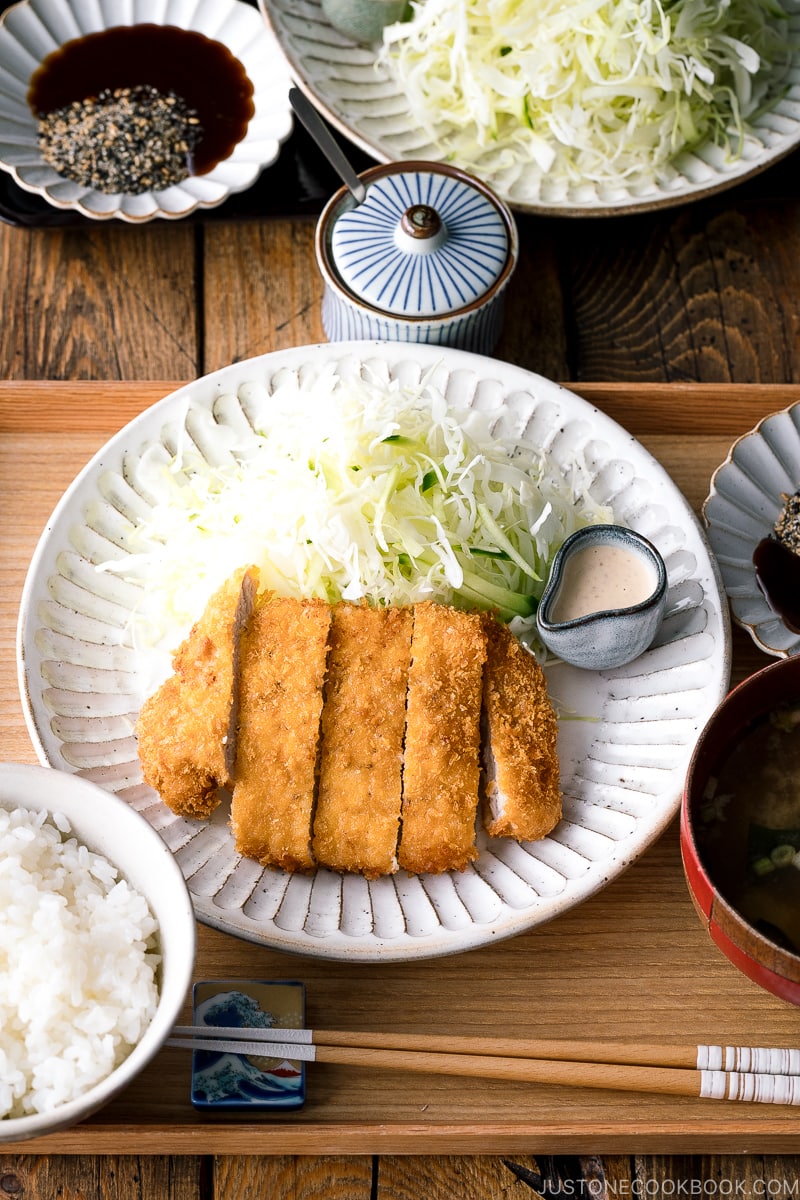
How to Make Best Tonkatsu at Home
Ingredients You'll Need:
- Pork – There are two cuts of meat we typically use for this dish: pork loin (ロースrōsu) or tenderloin/fillet (ヒレhire). Both cuts are fairly lean, but pork loin has a layer of fat that gives the Tonkatsu an extra tender bite when cooked properly (And as with most recipes, the quality of the meat makes all the difference.).
- Salt and pepper
- Flour
- Egg
- Panko – Please get a Japanese brand of panko as non-Japanese brand of panko seem a bit different.
- Neutral flavored oil for deep frying
- Tonkatsu sauce
- Sesame seeds (optional)
5 Important Tips to Remember
Tonkatsu is actually one of the quickest and simplest meals you can make at home. You just need to know a few tricks to make the perfect Tonkatsu.
Tip #1: Moisten panko
This is a trick I learned over a decade ago. In Japan, you can purchase a type of panko called Nama Panko (生パン粉; fresh panko), which is basically panko that has a little more moisture (think of it as the white, fluffy parts of bread). To re-create this type of panko, I spray a little water—not pour!—to moisten the panko first (more on this in the recipe).
Tip #2: Make slits on the connective tissue of the pork
Make several slits on the connective tissue (white area) between the meat and fat. The reason why you do this is that red meat and fat have different elasticities, and when they are cooked, they will shrink and expand at different rates. This will allow Tonkatsu to stay nice and flat when deep frying and prevent it from curling up.
Tip #3: Pound pound pound
Getting high-quality ingredients for a recipe that only requires a few things is very important. For this Tonkatsu recipe, you can also improve the texture of the meat and make it extra tender by pounding it first (If you don't own a meat pounder, just use the back of your knife! That's what I did in my college days).
Tip #4: Double fry
The key to great Tonkatsu is to double fry the pork and not to overcook the meat. After deep-frying the pork once, let it sit to continue cooking on the inside with remaining heat. After a few minutes, deep fry it a second time to get that perfectly crispy, golden cutlet.
If you're new to deep-frying, I have The Ultimate Guide: How to Deep Fry Foods at Home that will walk you through all the steps with helpful tools.
Tip #5: Clean the oil between batches
Scoop up fried crumbs in the oil with a fine-mesh strainer. It's very important to keep the oil clean (crumbs free) so it does not turn dark and affect the results of the crust.
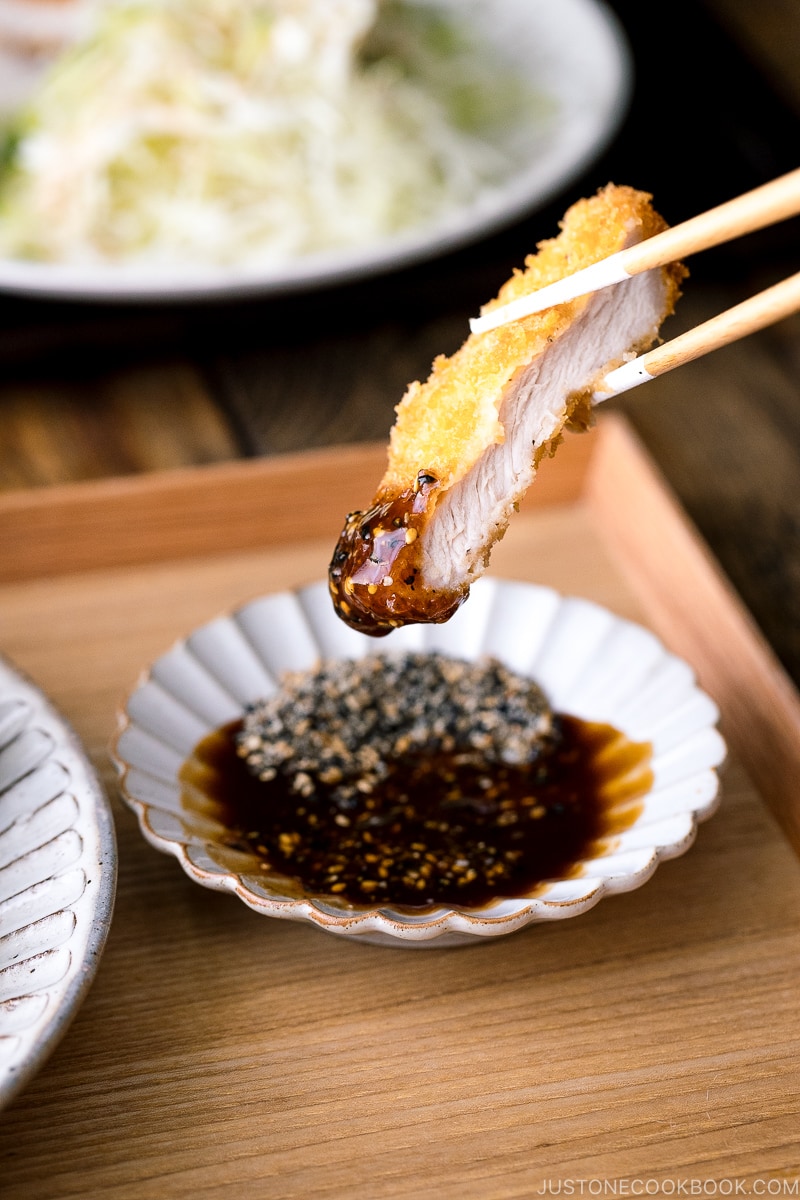
How to Dispose of the Cooking Oil
I often get questions about how to deal with used cooking oil after deep-frying, and I have a few solutions:
First of all, never pour it down the drain. Not only is it destructive to the environment, but it can also solidify and cause blockages in the pipes.
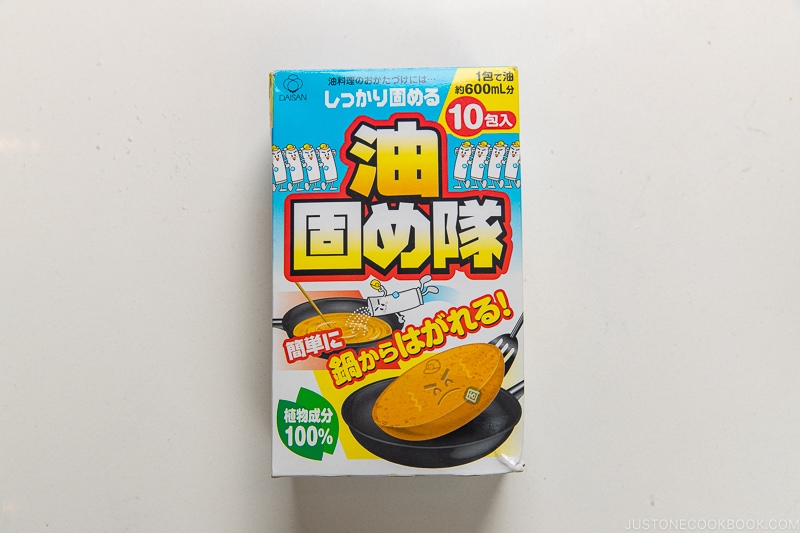
The quick and easy solution is to buy the oil-solidifying powder that you can find at Japanese grocery stores, Asian grocery stores, or online. The powder allows you to dispose of the used oil easily in the trash (Directions for this below).
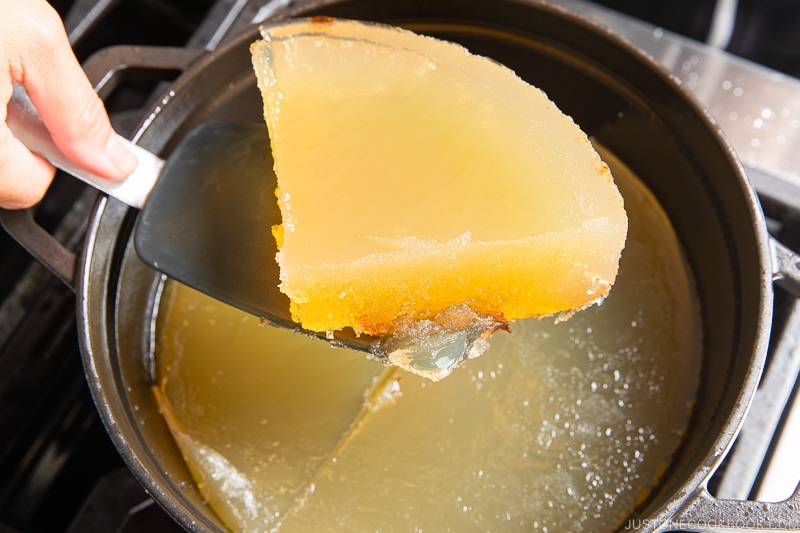
If you can't find the powder for any reason, then allow the oil to fully cool, and pour it into an empty receptacle (bottle, milk carton, etc.), and toss it in the trash.
Be sure to follow your local trash disposal and recycling procedures before disposing of the cooking oil, as this information varies from place to place. In my neighborhood, the local recycling facility accepts used cooking oil, so we bring the used oil there in a bottle and pour it into the designated container.
Don't Like Deep Frying? Make My Baked Tonkatsu!
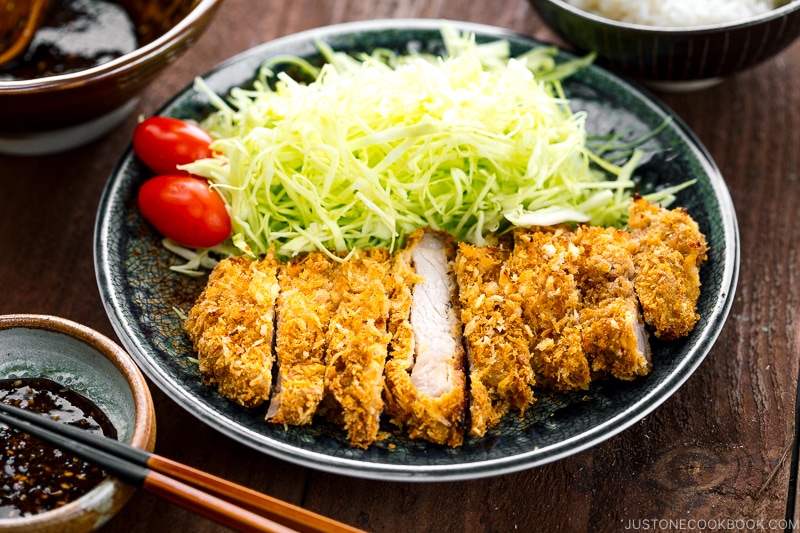
For those of you who still prefer a lighter version of Tonkatsu and don't want to deep fry in your kitchen, you can check out my Baked Tonkatsu recipe. It's wildly popular and JOC fans simply love it!
More Delicious Tonkatsu Recipes
- Baked Tonkatsu
- Chicken Katsu
- Katsudon
- Katsu Curry
- Katsu Sando
- Miso Katsu
- Gluten-free Chicken Katsu
Also, check out my list of 17 Best Katsu & Furai Recipes.
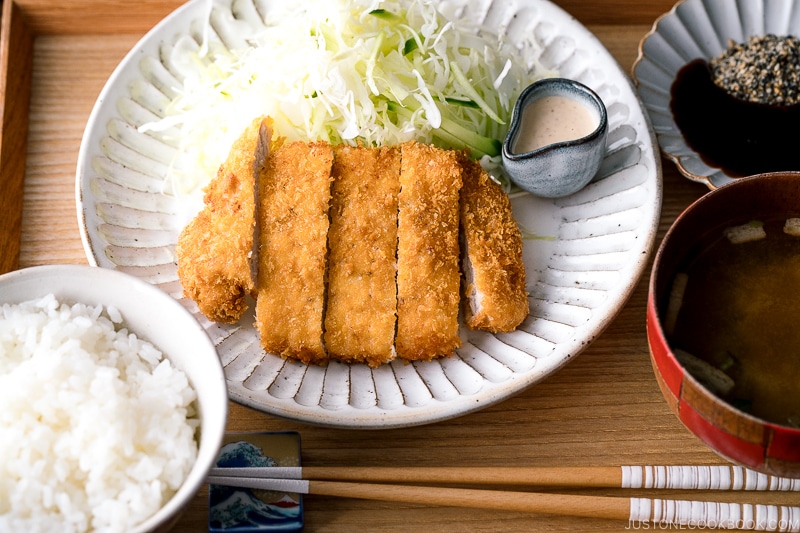
Wish to learn more about Japanese cooking?Sign up for our freenewsletter to receive cooking tips & recipe updates! Andstay in touch with me on Facebook, Pinterest, YouTube, and Instagram.
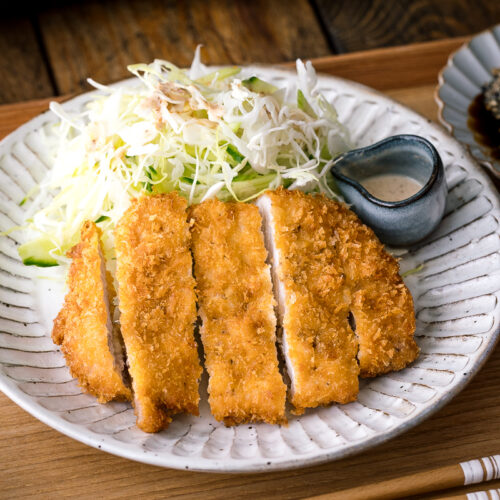
Tonkatsu (Japanese Pork Cutlet)
Crispy on the outside and juicy on the inside, this is the best homemade Tonkatsu (Japanese Pork Cutlet) recipe that my family loves!
Servings: 2
Prevent your screen from going dark
- 2 boneless pork loin chops (½ inch thick) (thickness: 1-1.3 cm, about ½ inch; weight: 100 g, 3.5 oz each piece)
- ½ tsp kosher salt (Diamond Crystal; use half for table salt)
- ⅛ tsp freshly ground black pepper
- 3 cups neutral-flavored oil (vegetable, rice bran, canola, etc.) (for deep-frying; I recommend 1¾-2 inches (5 cm) of oil in the pot)
For the Tonkatsu Breading
- 2 Tbsp all-purpose flour (plain flour)
- 1 large egg (50 g w/o shell)
- ½ Tbsp neutral-flavored oil (vegetable, rice bran, canola, etc.) (for the egg)
- ½ cup panko (Japanese breadcrumbs) (If you are in Japan, get nama panko (生パン粉). You may need more panko depending on the brand)
For Serving
- ¼ head cabbage (optional; tonkatsu is typically served with shredded cabbage)
- 1 Persian or Japanese cucumber
- 2 Tbsp Japanese sesame dressing (for my homemade recipe, click here)
Japanese Ingredient Substitution: If you want substitutes for Japanese condiments and ingredients, click here.
-
Gather all the ingredients. For Tonkatsu, I highly recommend getting fresh panko (we call it nama panko) from a Japanese grocery store. If you can't get it, follow my instructions to make fresh panko. Make sure to use a Japanese brand of panko from Japan. Western "panko breadcrumbs" are a bit different from authentic Japanese panko.
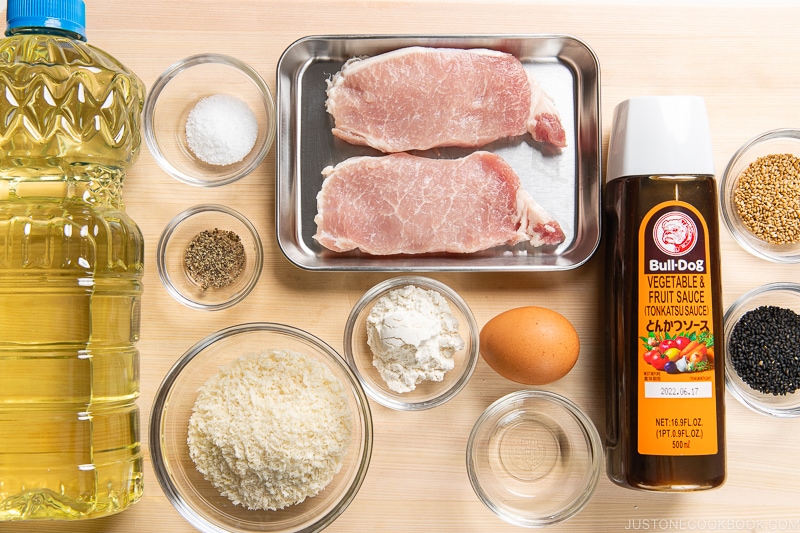
To Prepare the Shredded Cabbage (Optional)
-
You can always cut the cabbage super thinly with a sharp knife, but I love this cabbage slicer and it saves time and energy! I also thinly slice the cucumber diagonally, then cut them into thin strips. Toss the cabbage and cucumber together and set aside.
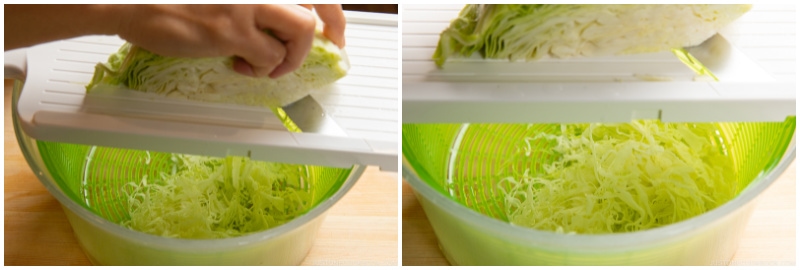
To Make the Sesame Tonkatsu Dipping Sauce (Optional)
-
Grind the white and black toasted sesame seeds with a Japanese pestle and mortar. Leave some seeds unground for texture.
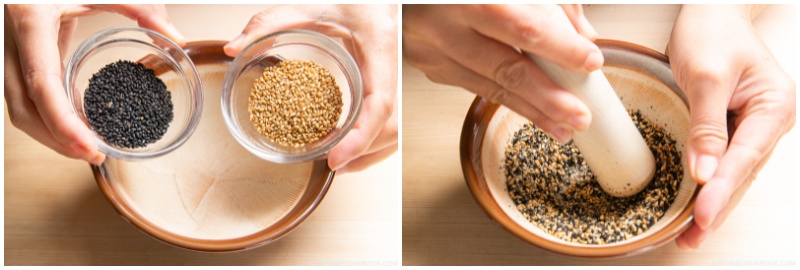
-
In individual small plates or bowls, serve 1 Tbsp of the ground sesame seeds and add the tonkatsu sauce. Each person can mix it together when they are ready to eat.
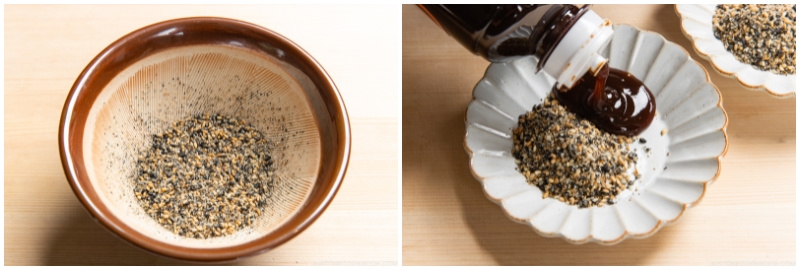
To Make the Fresh Panko
-
Put store-bought dry panko in a deep dish and spray with water until the panko is moist (I use this mister). Set aside for 15 minutes, or until the panko becomes soft and tender. You can also use a food processor to make fresh panko from shokupan (Japanese Pullman bread).
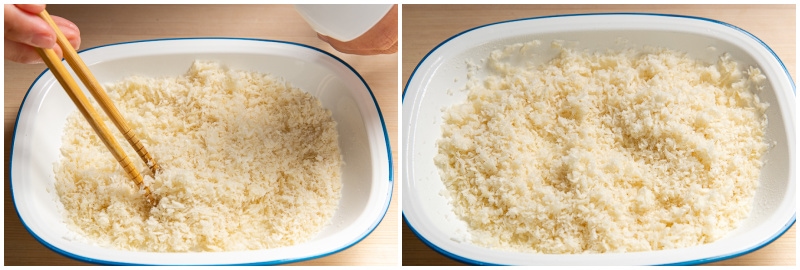
To Prepare the Pork
-
With a sharp knife, remove the extra fat and make several slits on the connective tissue (white area) between the meat and fat. Red meat and fat have different elasticities, and when they are cooked, they will shrink and expand at different rates. These slits will allow the tonkatsu to stay nice and flat when deep-frying and prevent it from curling up.
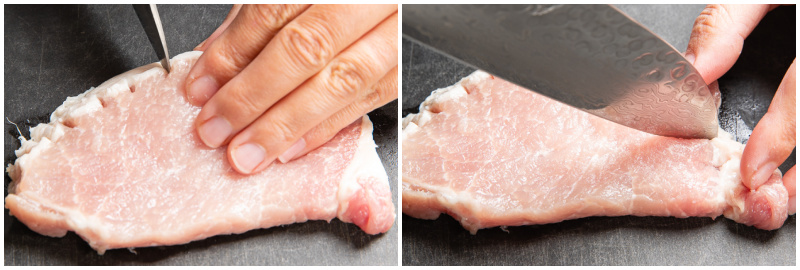
-
Flip the meat and make several slits on the other side of the connective tissue.
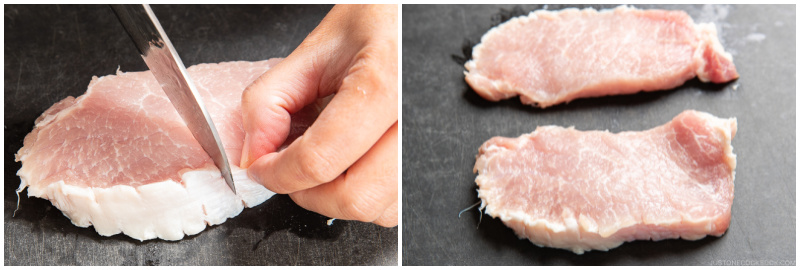
-
Pound both sides of the meat with the back of a knife or a meat tenderizer/mallet.
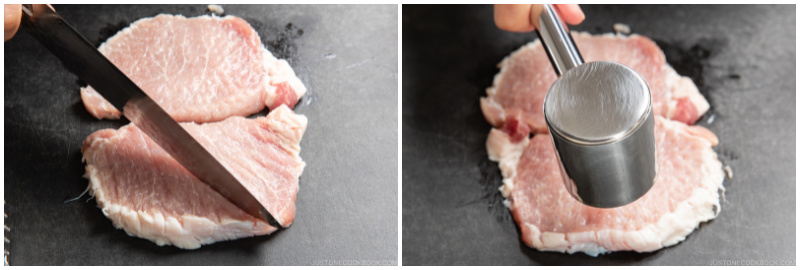
-
Mold the meat back into its original shape with your hands.
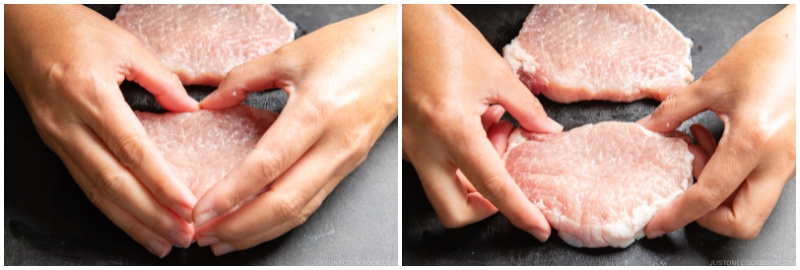
-
Season both sides of the meat with salt and pepper.
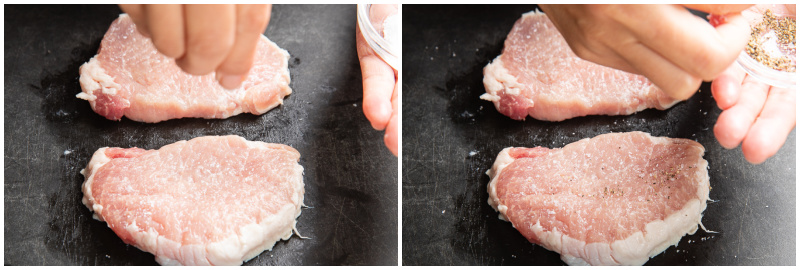
To Bread the Pork
-
Crack the egg in a deep dish and add the oil. Whisk together until well combined. By adding oil, the meat and breading won't detach from each other while deep-frying and the juice and flavor from the meat will not escape easily. Prepare a deep dish for the flour, too.
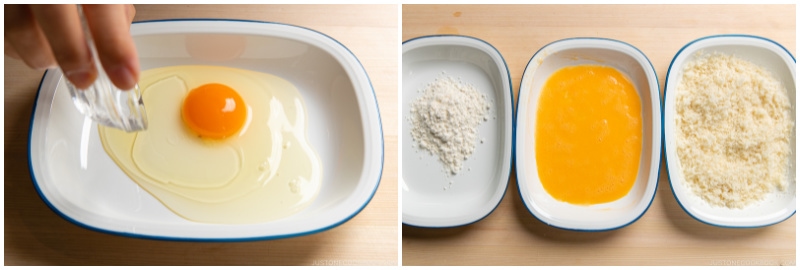
-
Dredge the pork in the flour and dust off any excess. Excess flour will create a coating that prevents the egg mixture from adhering to the pork. Then, dip the pork into the egg mixture and coat well.
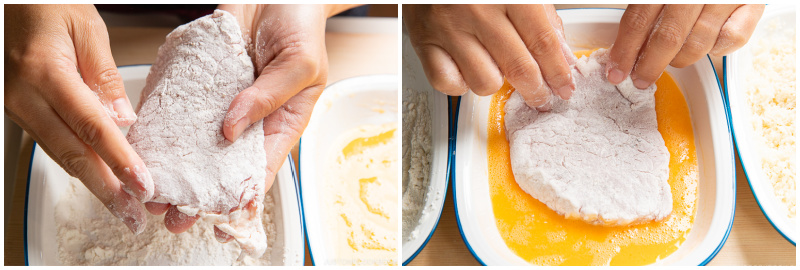
-
Dredge the pork in the panko, gently pressing down the panko onto the pork and then gently shaking off any excess before placing the pork pieces onto a tray or plate. While deep-frying, the panko will "puff up," so at this stage they don't have to be fluffy. Set it aside for 5-10 minutes so the breading will set.
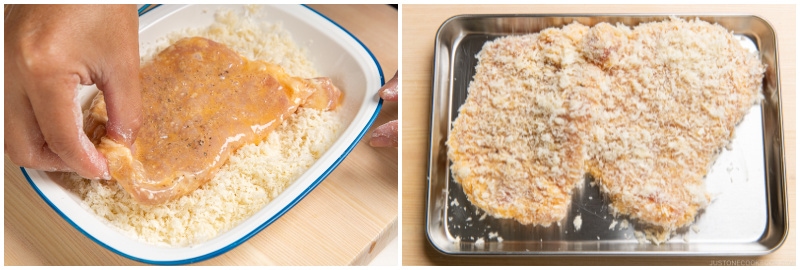
To Deep-Fry
-
Add the oil to the pot and bring it to 340ºF (170ºC) over medium heat. If you don't have a thermometer, stick a chopstick in the oil and see if tiny bubbles start to appear around the tip of the chopstick. Alternatively, you can drop one piece of panko into the oil; if it sinks down to the middle of the oil and immediately pops back up to the surface, then the oil is ready.
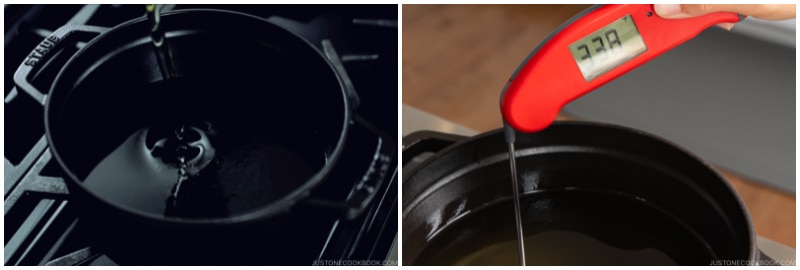
-
Gently put one piece of pork into the oil and cook for 1 minute (without flipping). Don't touch the pork for 30 seconds. Why one piece? You don't want to reduce the oil temperature drastically. The size of the bubbles should be big when you add the pork. Keep watching the oil temperature and make sure it doesn't go over 340ºF (170ºC) or else the breading will get dark too quickly while the pork will be undercooked.
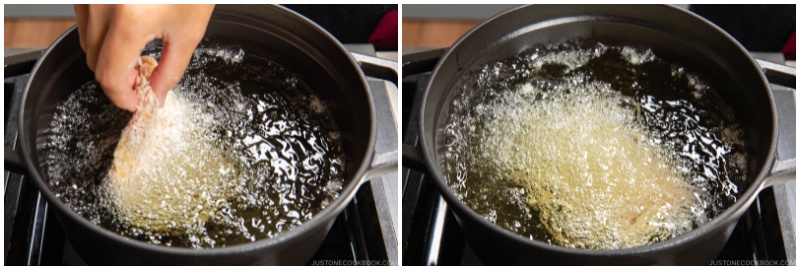
-
After a minute, flip the pork and cook the other side for 1 minute.
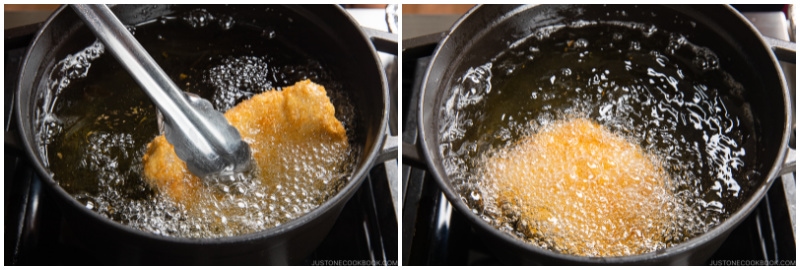
-
Take out the pork and remove excess oil by holding it vertically over the pot for a few seconds while the oil drips off. Place it on a wire rack or paper towel and let it sit for 4 minutes. The hot oil on the exterior will slowly continue to cook the meat as it sits.
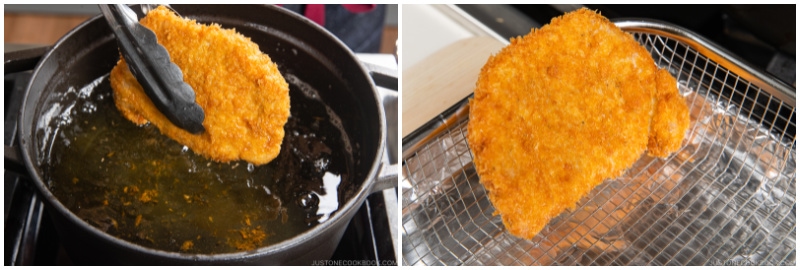
-
Turn off the heat temporarily and scoop up and discard any fried crumbs in the oil with a fine-mesh strainer. It's very important to keep the oil clean and crumb free so the oil does not get darker and dirtier with burnt crumbs. Turn on the heat and bring the oil back to 340ºF (170ºC).
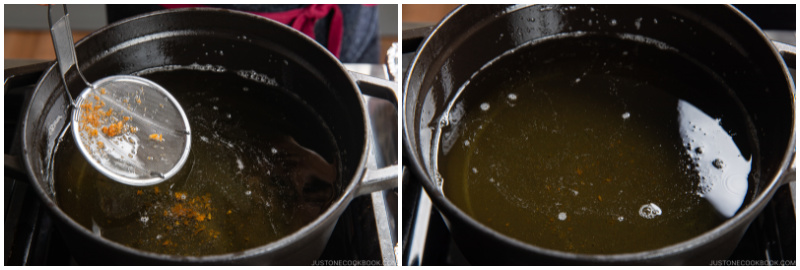
-
While the first cutlet is resting on the wire rack, deep fry the second piece of pork for 1 minute without flipping. Remember not to touch it for 30 seconds.
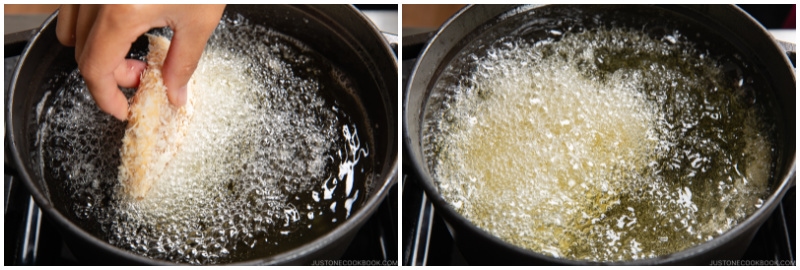
-
Flip and cook the other side for 1 minute.
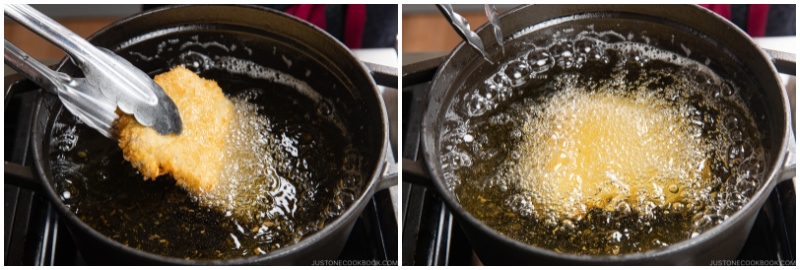
-
Take out the pork and remove the excess oil as before. Place it on the wire rack and let the residual heat cook the pork for 4 minutes. Scoop up and discard the fried crumbs in the oil with a fine-mesh strainer.
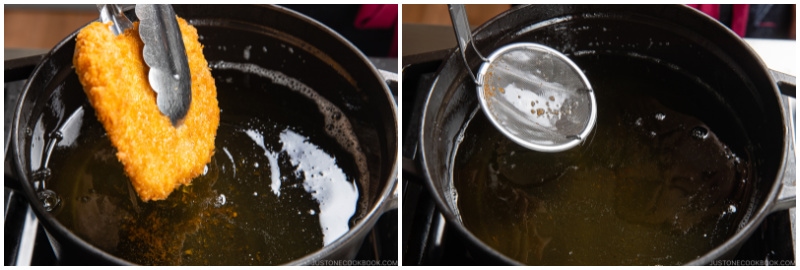
-
The first piece of pork should be ready for its second frying. Bring the oil to 355ºF (180ºC) and fry the pork for 30 seconds on each side. Remove from the pot and drain the excess oil by holding the cutlet vertically over the wire rack or paper towels for 2 minutes. This prevents the breading from getting soggy on one side.
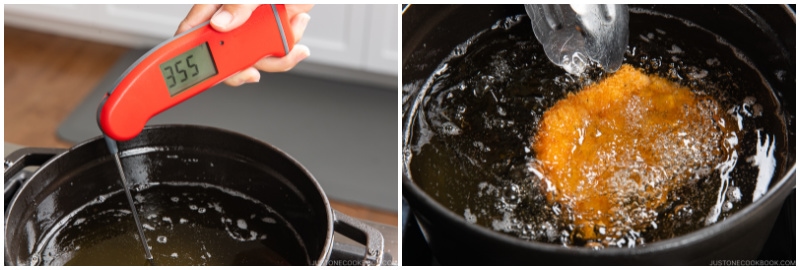
-
Scoop up and discard the fried crumbs in the oil, then continue the second frying of the second cutlet. Remove from the pot and drain the excess oil as before.
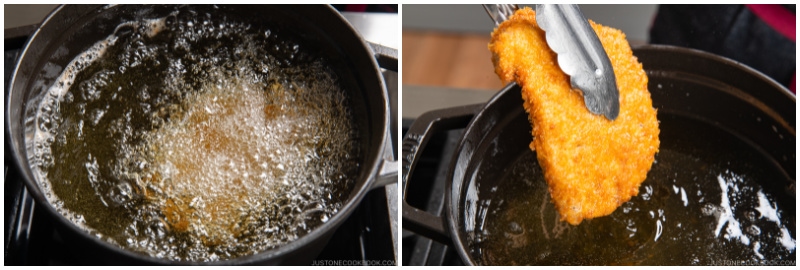
To Serve
-
Cut the tonkatsu into ¾-inch (2 cm) wide pieces.
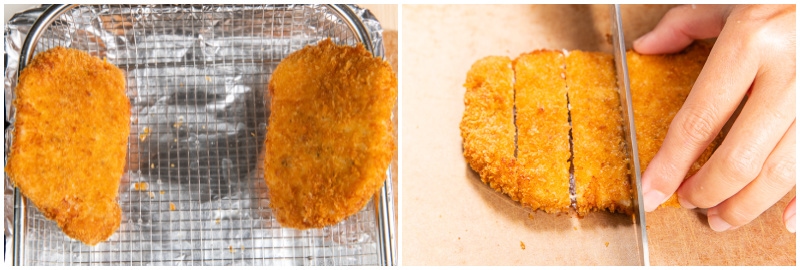
-
Transfer to a plate and serve it with the shredded cabbage and cucumber, the sesame dressing in a small cup, and the sesame tonkatsu dipping sauce on the side.

To Store
-
You can store leftovers in an airtight container and freeze for up to a month. To reheat, put the defrosted or frozen tonkatsu on a baking sheet lined with aluminum foil or parchment paper. Bake at 350ºF (180ºC) for 15-20 minutes if defrosted or 30-40 minutes if frozen. Check if the inside is warm before serving.
To Dispose of the Used Cooking Oil
-
Please follow your local guidelines for disposing of cooking oil. In my neighborhood, we can bring used cooking oil to the recycling center and dump it into the designated container, so it's very easy.
-
If you are using a Japanese oil solidifier, add the powder into the hot oil (right after deep frying) and mix well.
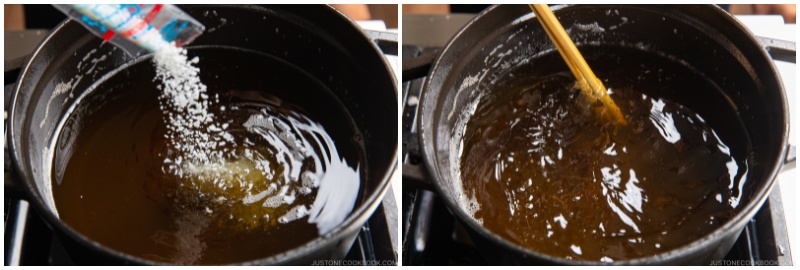
-
Set it aside and the oil will solidify as it cools (it may take overnight to completely solidify).
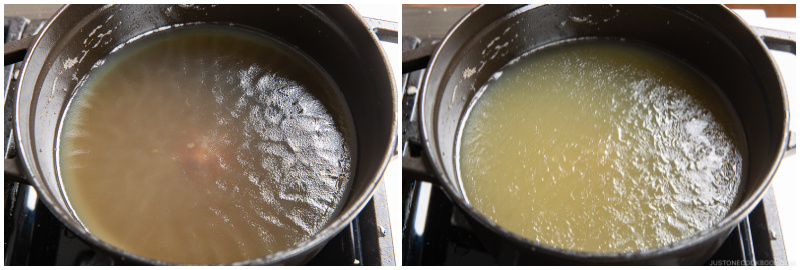
-
Cut into small pieces and discard them in the trash.
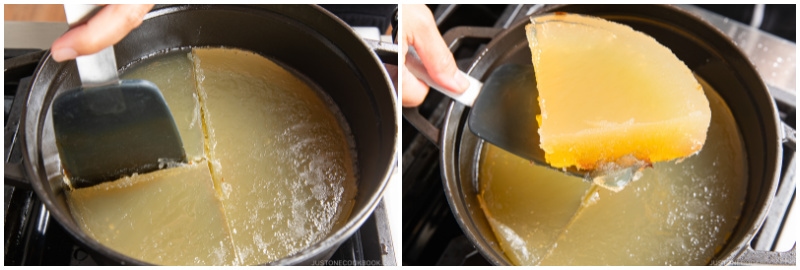
Calories: 523 kcal · Carbohydrates: 15 g · Protein: 27 g · Fat: 37 g · Saturated Fat: 7 g · Polyunsaturated Fat: 19 g · Monounsaturated Fat: 10 g · Trans Fat: 1 g · Cholesterol: 131 mg · Sodium: 491 mg · Potassium: 458 mg · Fiber: 1 g · Sugar: 5 g · Vitamin A: 96 IU · Calcium: 74 mg · Iron: 2 mg
Course: Main Course
Cuisine: Japanese
Keyword: panko, pork
©JustOneCookbook.com Content and photographs are copyright protected. Sharing of this recipe is both encouraged and appreciated. Copying and/or pasting full recipes to any website or social media is strictly prohibited. Please view my photo use policy here.
If you made this recipe, snap a pic and hashtag it #justonecookbook! We love to see your creations on Instagram @justonecookbook!
Editor's Note: This post was originally published on July 12, 2011. The post has been updated with new images, new content, and a new video in August 2021.
whittakersaraing1952.blogspot.com
Source: https://www.justonecookbook.com/tonkatsu/
0 Response to "Top Round Beef Cutlet Recipe Panko"
Post a Comment